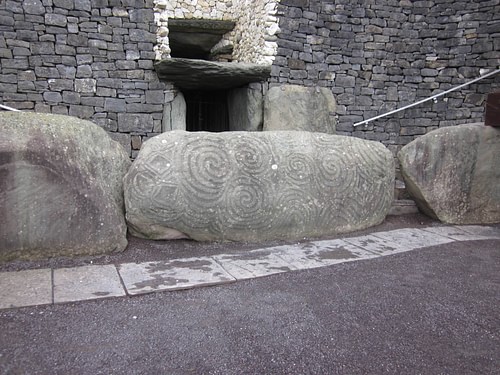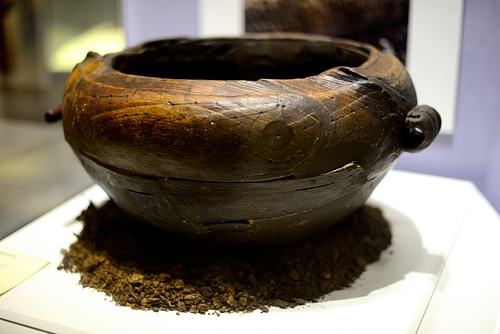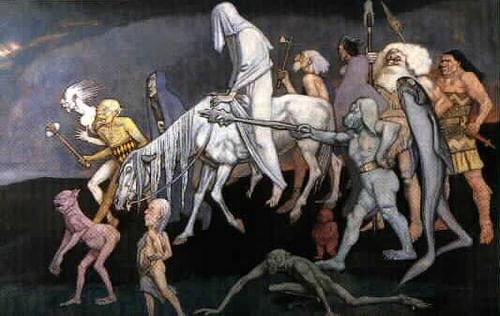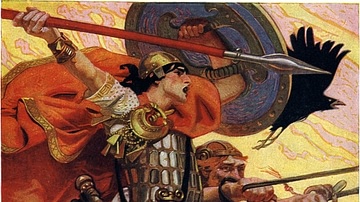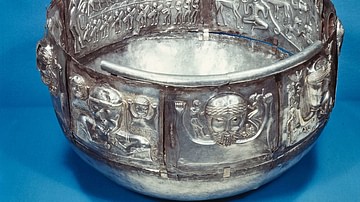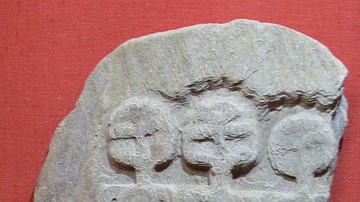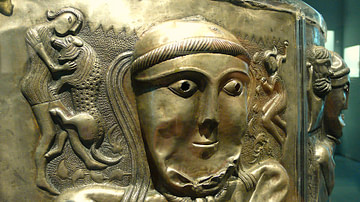
The Dagda (also Daghda, Daghdha, Dagdae, or Dagda Mór), usually written with the definite article, is one of the most important gods in Irish-Celtic mythology. He appears as a multi-talented warrior-leader of the Tuatha Dé Dannan, invaders of ancient Ireland who win a battle against the resident Fir Bolg. Another battle follows, this time against the seafaring Fomorians, and again the Tuatha Dé Dannan are victorious. It is the Fomorians who set the Dagda his famous challenge of eating a huge amount of porridge from his own magical cauldron. With his mighty club, inexhaustible cauldron, and great talent playing the harp, the Dagda was a universal god in Irish mythology considered to dwell in many places, including at Newgrange. As his warrior character, the Dagda is killed by Caitlín, queen of the Fomorians.
Names
Dagda means the 'good god' and the name often appears with a variety of spellings. The sense of 'good' in this context is 'many-skilled' as the Dagda was considered a master craftsman, warrior, magician and ruler. The god may also be referred to as Eochaid Ollathair, meaning 'father of all' or 'mighty father', Ruad Rofhessa, meaning 'lord of great knowledge', or Deirgderc, 'red eye' (referring to the sun). Although recognised by scholars as an important early Irish-Celtic deity, his precise significance is not known. Some have identified him as a sky god and ancestor deity similar to Cronus in Greek mythology. In any case, it is thought that these ancient Celtic gods were not specifically a focus of religious rituals in their particular honour. In contrast, his character as a divine warrior is better represented and seen in the mythological tales of early Irish history which were first written down from around the 8th century CE onwards.
We do know that in the religion of the ancient Celts the Dagda was a prominent figure in the festival of Samhain (aka Samain) which, on 1 November and including the evening of the 31st, celebrated the end of the old year and the beginning of the new. This was also a time when the spirits of the Otherworld could be best contacted. If the Dagda and the war goddess the Mórrigan, sometimes known as the 'queen of demons', came together at this time, then their sexual union would guarantee the fertility and prosperity of the tribe and its harvests and livestock in the coming year. The Dagda was also thought to have had intercourse with two other goddesses during Samhain, these are Boand (aka Boann, goddess of the Boyne River) and Indech (daughter of a renowned warrior of the same name). For this reason, in Gaelic oral traditions in Ireland and Scotland, Samhain was considered the most auspicious time to become pregnant.
Family Relations
The Dagda is sometimes considered the son of Eithne, the daughter of Balor (aka Balar), leader of the Fomorians (see below). Consequently, the Dagda is the brother of Lugh, another important god and cultural hero who ruled Ireland for 40 years. The Dagda has no particular home but is, rather, thought to be present everywhere and anywhere. In later traditions, he is said to have had four palaces under the earth.
The Dagda has a daughter, Brigid (aka Brigit), the goddess who is a strong force of fertility, a source of great wisdom and poetry, and a dispenser of healing in pre-Christian Ireland. The Dagda's most famous sons are Cermait and Angus Óg (aka Mac Óc), the 'young god' who represented youth, beauty, and possibly love. The latter's mother was Boand whose husband is very often cited as Nechtan, a sort of Poseidon/Neptune figure. The Dagda, disguised as Eochaid Ollathair in some versions, sends Nechtan away on a journey while he seduces his wife. The Dagda casts a spell on Nechtan so that he does not feel hunger or a sense of time passing and only after nine months does he return home. The hapless Nechtan thinks that he has only been away for one day and so does not realise his wife has been pregnant and the child given to his foster-father Elcmar.
Other children of the Dagda, and he has many, include Áed Minbhrec, Bodb Derg and Midir (although he is sometimes the Dagda's brother), all three being prominent members of the Tuatha Dé Dannan, the pre-Christian Irish gods or supernatural race who brought elements of civilization in the Irish Mythological Cycle. Another daughter of the Dagda is Ainge, a minor figure connected with forests.
The Dagda's Treasures
The Dagda, perhaps surprisingly for such a revered figure, is generally portrayed as a peasant-like warrior who wears a short tunic and is not overly blessed with good manners. The Dagda has a great cauldron with which he can magically feed each and every member of his followers. This cauldron was regarded as one of the four treasures of the Tuatha Dé Danann, and the Dagda is one of the great warrior leaders of this race. Cauldrons were very important in Bronze Age cultures, and for the Celts, they had associations with funerals and were used as votive offerings.
Another plentiful food source in the Dagda's possession is an ever-abundant fruit tree. The god is also the owner of Brug na Bóinne or Newgrange in County Meath - both an otherworldly residence and the Neolithic site - before he gives it to his son Angus Óg.
The Dagda is first and foremost a warrior, and his club was said to be so heavy that it had to be moved around on wheels and, when it was dragged, it left furrows so deep they were used as boundary markers between provinces. When swung in anger, this terrific club could kill nine men at once. The club also had the powers to bring the dead back to life. Other skills in the Dagda's possession are the ability to play the harp, with which he can play three types of tune to influence his listeners to sleep, laugh, or grieve. This harp is so celebrated it has a name: Úaithne. Finally, the Dagda has two magical pigs, one living and another forever cooking on a fire and ready to be eaten.
Tuatha Dé Dannan & the Fir Bolg
The story of the Dagda's involvement in the invasion of Ireland is most famously told in the Cath Maige Tuired (aka 'The Battle of Mag Tuired'), an 11th-century CE text which collated earlier sources. Another source is the 11-12th-century CE Lebor Gabála ('Book of Invasions'). The invading Tuatha Dé Danann possess many great warriors with special powers, and the Dagda is foremost among them. Perhaps unsurprisingly, given the accomplishments of their leaders, the invaders are victorious against the current inhabitants, the Fir Bolg at Mag Tuired, a plain in Connacht in northwest Ireland. The defeated Fir Bolg then disperse to remote islands and to Scotland.
The Fomorians & Death
Another battle at the same place follows 27 years later, this time between the Tuatha Dé Danann and the Fomorians, who are either semi-divine beings or demonic pirates depending on which source one consults. The Fomorians are fierce fighters with a fearsome aspect - they have one arm, one leg, and one eye in some versions. Initially, the two groups live peacefully together and intermarry but a great battle will follow. In the meantime, the Dagda is obliged to build a fortress for Bres, who has become the ruler of both groups. This is a humiliating task, and other notable leaders must do similar ones, which leads to discontent amongst the Tuatha Dé Danann.
A conflict seems inevitable, but first, the Dagda goes into the Fomorian camp to spy on them, and then he offers a peace treaty. They reject his offer. The Fomorians then try to get the better of the Dagda by using his cauldron to make a prodigious amount of porridge and then forcing him to eat every last drop, in some versions after pouring the mass into a huge hole in the ground. The god finishes off the porridge easily, even nonchalantly licking the last bits of porridge from the cauldron with his finger and gobbling up all the side trimmings like roast pigs, goats, and sheep. The Dagda then hobbles home but not before he enlists the help of the Fomorian goddess Domnu in the coming conflict.
In the battle which follows, the Tuatha Dé Danann are led to final victory by Lugh, who kills the one-eyed Fomorian leader, Balor (aka Balar). Despite his prowess and flattening of great swathes of the Fomorian army, the Dagda does not survive the battle. He is killed by buck-toothed Caitlín, the wife of Balor, or, at least, later dies from a wound inflicted by her. In later and contrasting traditions, the Dagda does not die but reigns over the Tuatha Dé Dannan for 80 years before retreating to his underground palaces, likely a metaphor for the diminishing stature of Celtic gods following the spread of Christianity.
